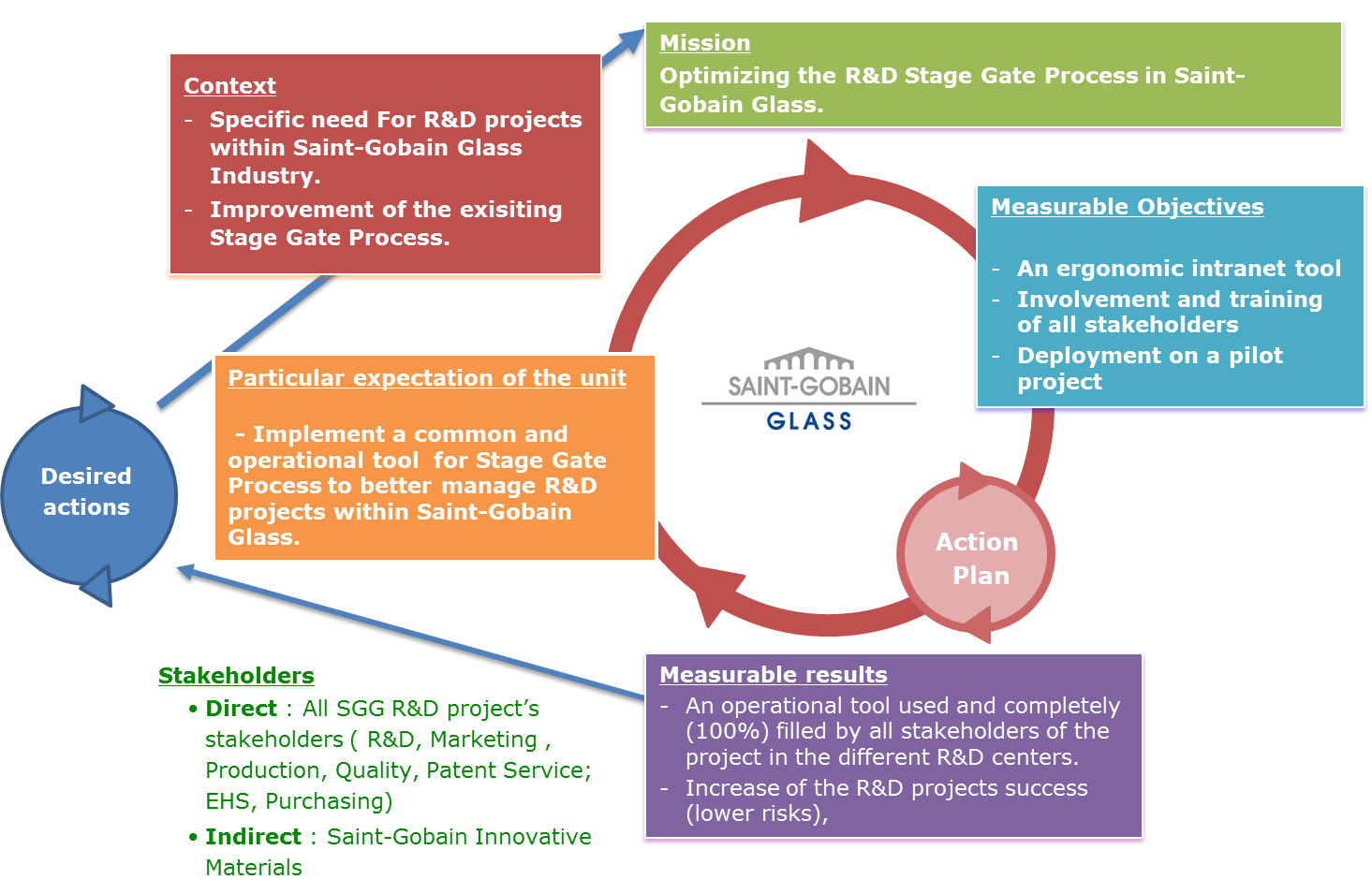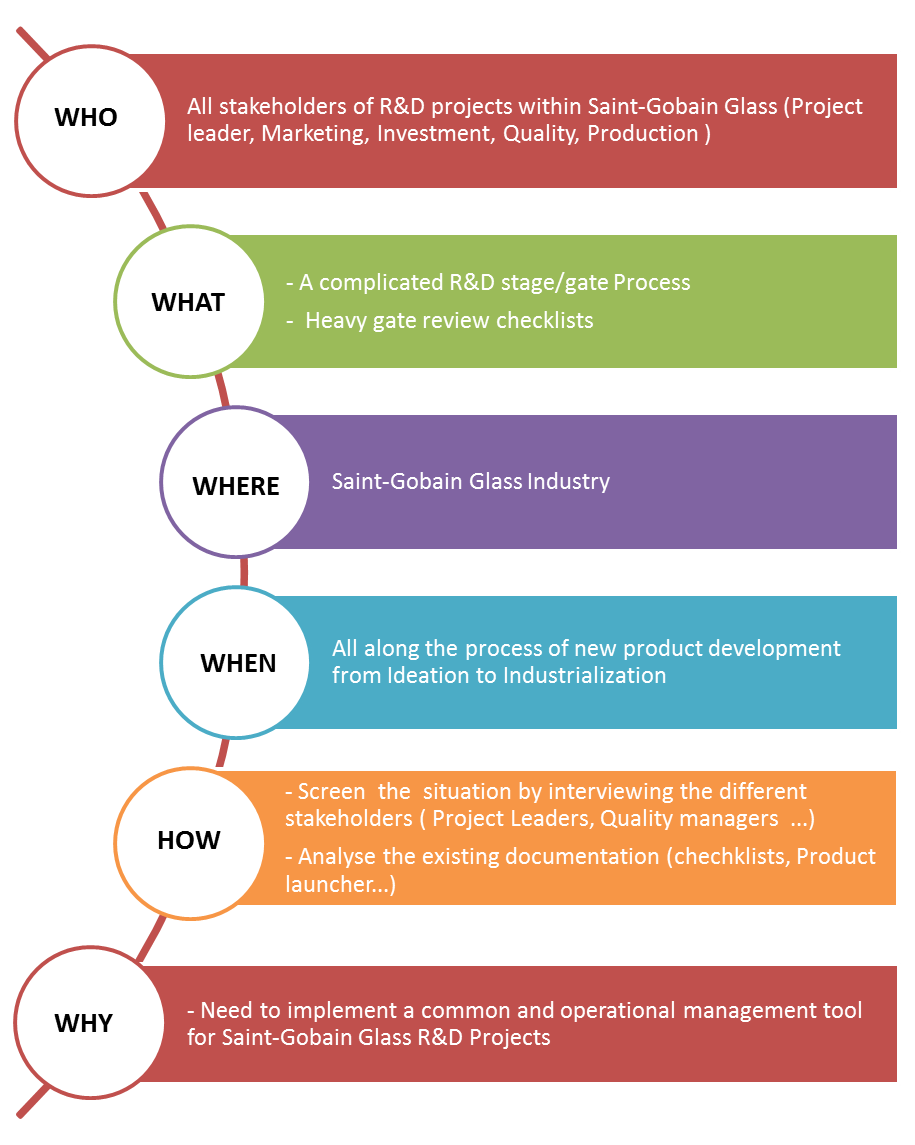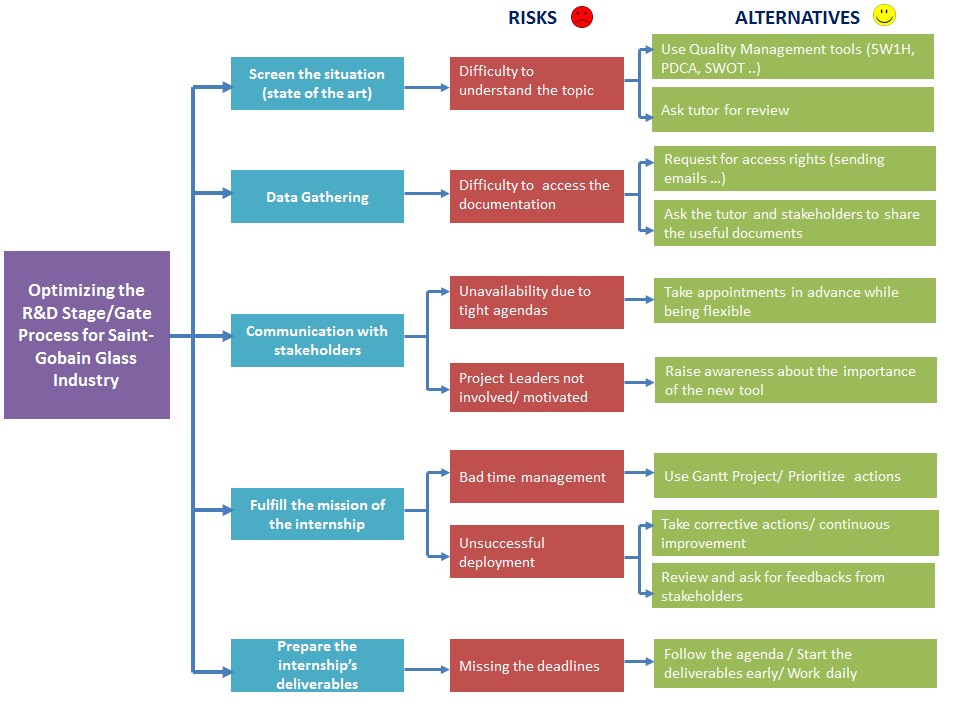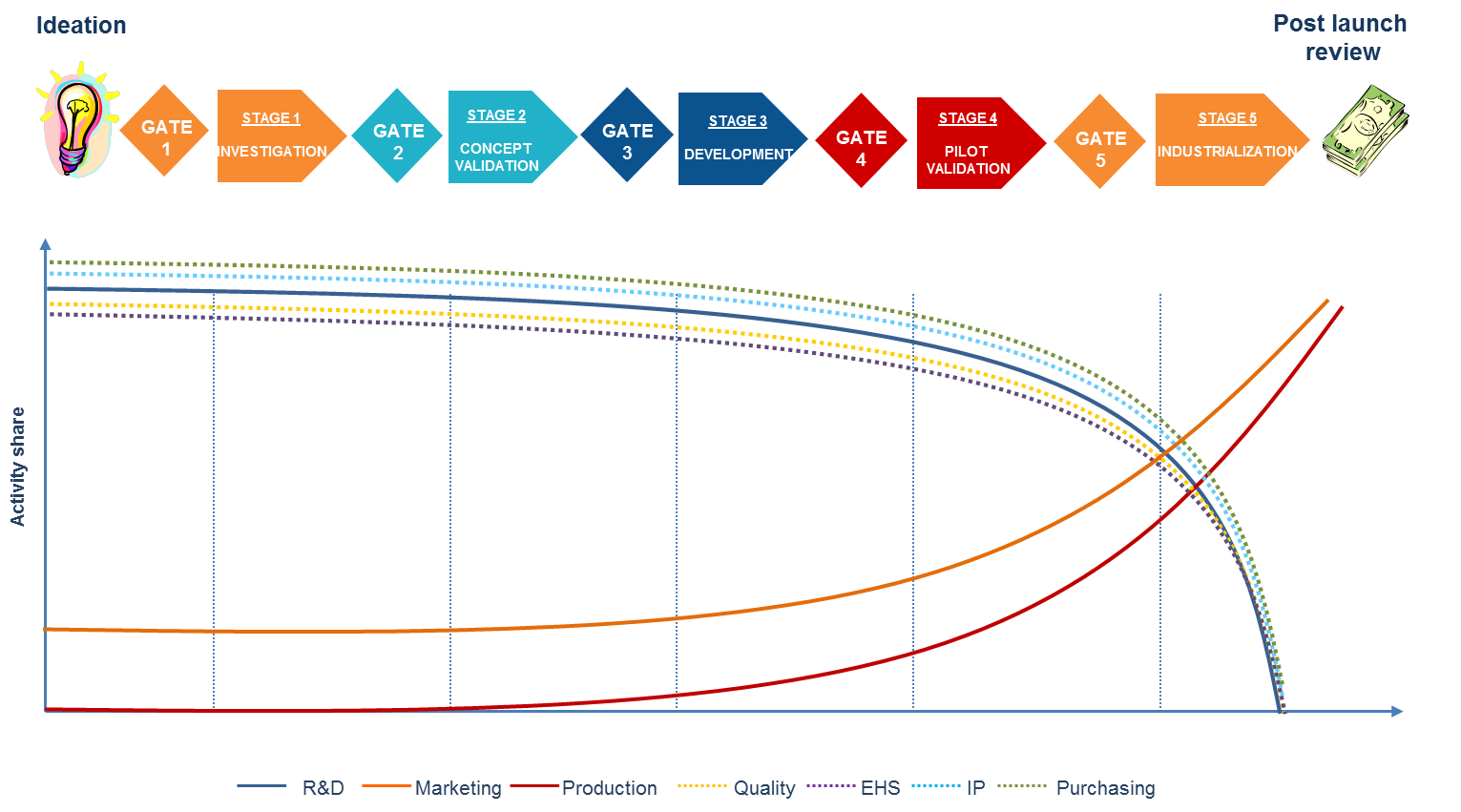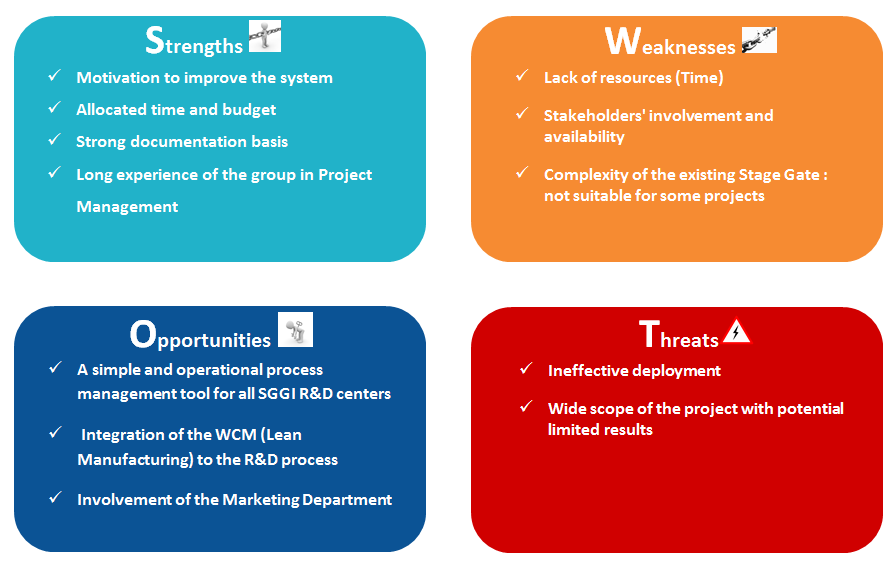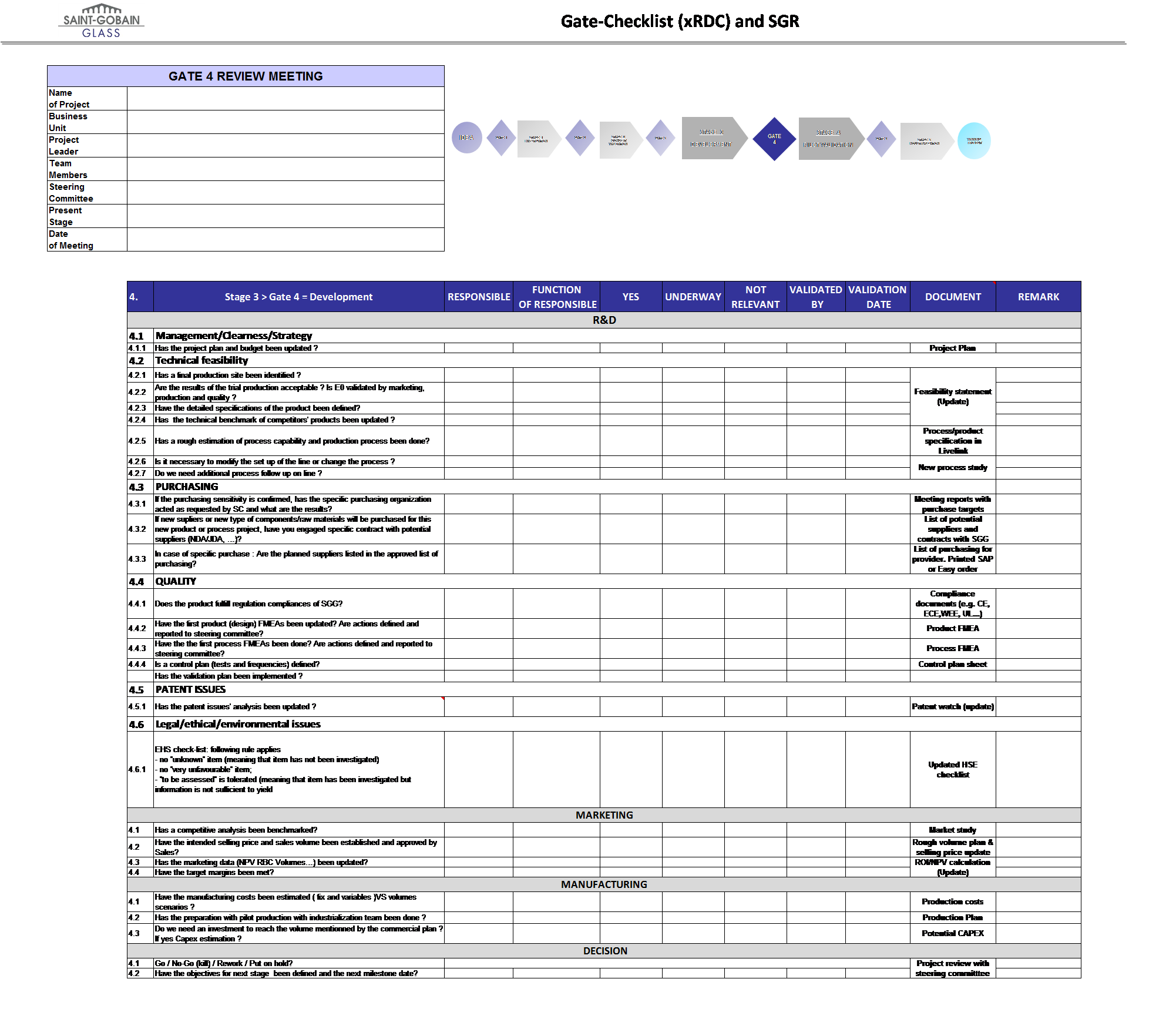The Stage Gate is roadmap with 5
stages and gates followed by a post launch review:
Gate 1: It is the initial idea screening to
decide if it offers a high potential value in Market
and fits the Business Unit objectives. If the
decision is favorable funding is granted for the
stage 1.
Stage 1: It is the preliminary investigation
to validate the idea and define the objectives of
the project.
Gate 2: It is the feasibility review to
evaluate the requests for the next stage.
Stage 2: It is the concept validation to
validate the idea by carrying a deep marketing and
feasibility analysis.
Gate 3: Authorize funding and resource
commitment for the following stage.
Stage 3: It is the development phase to:
o Produce a working prototype E0
at lab scale.
o Identify process capability.
o Analysis of the technical and
financial trial results.
o Marketing analysis and
business plan confirmation.
Gate 4: To approve the budget required for full
production trials.
Stage 4: It is the pilot validation to:
o Perform full scale trial
o Define the process improvement
o Calculate production costs
o Validate supply capacity and
confirm business plan
Gate 5: To review the results of previous stages
and the projected financial data.
Stage 5: The final stage is the
industrialization which means to implement the full
production run and successfully launch the project.
Following the full Stage Gate Process, a post launch
review is conducted in order to evaluate the
effectiveness of the process and suggest
improvements for future project launches.
The Stage Gate is cross-functional. It is driven by
R&D, Marketing and Production. The R&D
is supported by different departments including:
Quality, EHS, Patent Service and Purchasing. A
steering committee evaluates the performance of the
project during each gate review. This is a milestone
check and decision point based on the deliverables
of the checklists. The project cannot proceed and go
to the next stage without a “go” ahead decision.
The checklists contain a list of deliverables
to be checked based on the tasks done in the
previous stage.
3.2
Problem
The Stage-Gate process has been initiated to the
culture of Saint-Gobain R&D in order to better
manage innovation. Continuous improvement of the
existing process is at the heart of Saint-Gobain
Glass Industry objectives. The main goal is to
permanently meet the R&D project objectives and
fit the needs of project leaders.
The following table shows the key strengths and
weaknesses of the existing Stage-Gate process. This
helped to better screen the current situation and
identify the main areas of improvement.
+ + +
|
- - -
|
- Strong
documentation basis: Innovator
Handbook
of Saint-Gobain.
- Continuous
improvement. |
- Heavy
gate review checklists
- Many
tools used in the different R&D
centers (gate checklist, Product
Launcher)
- More
than one data base for R&D
projects
- Lack
of training of the project leaders
- Bureaucratic
system (many deliverables,
non-added-value items, many meetings
and committees…) |
Table 1:
Strong and weak points of the existing Stage Gate
Process[8]
Gate review is a critical check point and one of the
weakest area in new product development. In fact,
only 33% of firms have a robust operational Gate
review system [9]. Moreover, only 56 % of project
are successful and meet their sales targets.
The existing gate review in Saint-Gobain Glass is
not fully satisfactory and doesn’t fit the needs of
project leaders. The tool is considered heavy and an
extra work. Neverthless, this extra work if it is
well defined and optimized it is well worth the
effort as it yields to increased success rates,
greater profits and often shorter time to launch in
the market.
3.3 Problem
Solving methodology
In order to adopt a robust problem solving
methodology a Deming Circle was designed (Figure
12). SGRD refers to Screen, Go, Review and Deploy.
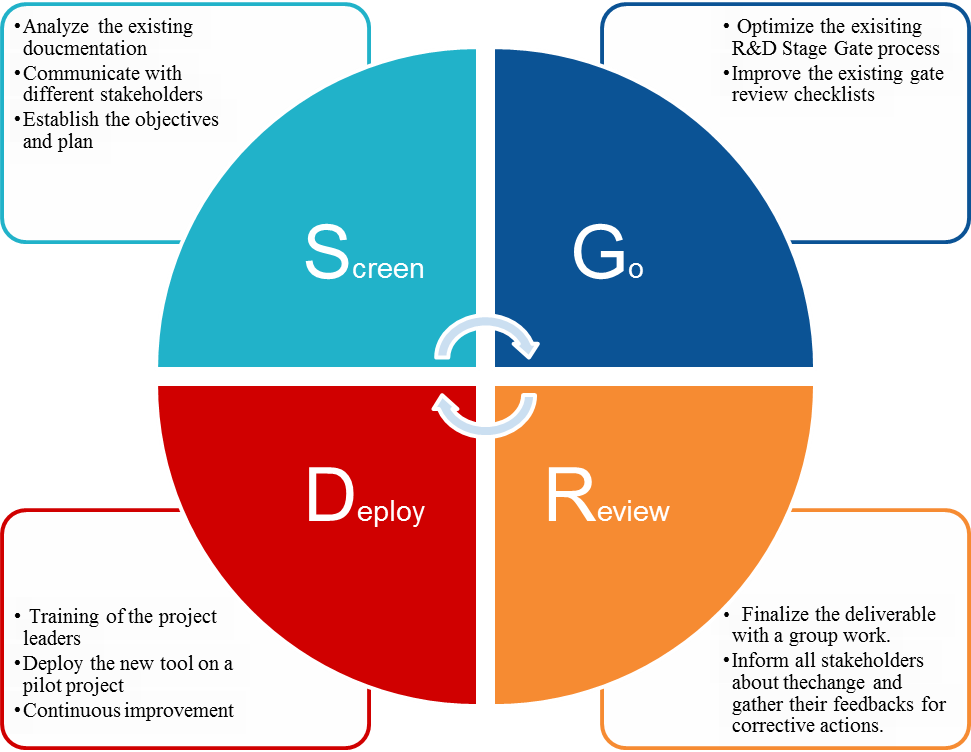 Figure
12
Figure
12 : SGRD Saint-Gobain R&D Deming
wheel [8]
Screen: The first
step was to understand the existing system. The
state of the art analysis is critical since it
helps to identify the main areas of failures and
improvement. Analysis of the existing
documentation and communicating with the
stakeholders were important to do a better
screening. Afterwards, a deep analysis was
conducted on problem identification and the plan
of the action plans.
Go: The DO phase and putting into
practice the tasks planned in the screening
phase. The core project is to improve and
implement a new gate review checklist while
tackling the weak points and failures of the
existing system. Interviewing the stakeholders
mainly the project leaders was the method
adopted.
Review: Upon completion of the GO
phase and once the deliverables are ready, a
checking phase is essential in order to have
feedbacks from stakeholders, identify the
potential problems and take corrective actions
as necessary.
Deploy: The final phase is the deployment
of the new tool on a pilot project. Therefore,
training of project leaders is highly needed to
ensure that they assimilate and know how to
operate it. Continuous improvement of the new
tool is also one of the main tenets of this
work.
Aligning with the SGRD described previously, a
plan was plotted using Gantt project shown in
Appendix 1.
The main objective was to implement an
integrated, evolving process that builds agile
methods. The new Stage Gate process is not a
lock-step rigid process. It is a tool that helps
to have a better project management system
rather than a heavy project-control mandatory
tool. It is therefore tailored to the needs of
the project.
The main objective was to implement an
integrated, evolving process that builds agile
methods. The new Stage Gate process is not a
lock-step rigid process. It is a tool that helps
to have a better project management system
rather than a heavy project-control mandatory
tool. It is therefore tailored to the needs of
the project.
3.3.1
SCREEN
To better screen the situation, analysis of the
existing documentation was essential (Innovator
Handbook, Gate Checklists, Product Launcher,
Gate review presentations …). Moreover,
stakeholders helped me to better understand and
assimilate the situation and provided me with
needed information.
Then a short anonymous questionnaire was
prepared and sent to Project Leaders (Figure
13):
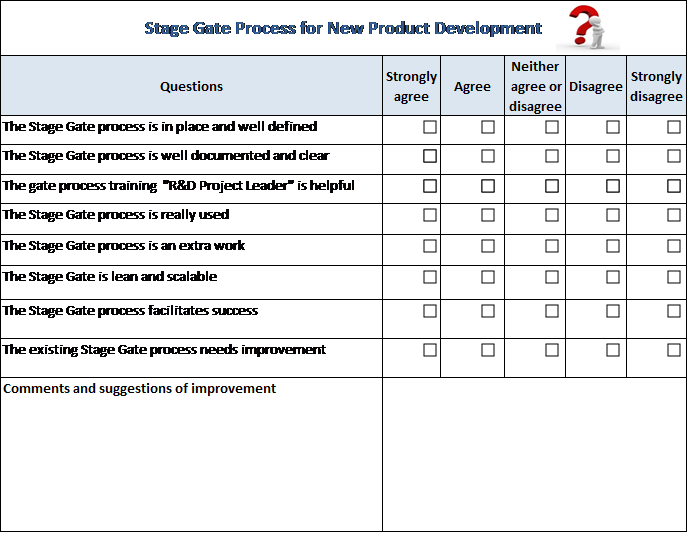 Figure 13
Figure 13 : Questionnaire about the
existing Stage Gate Process [8]
Project Leaders were
reactive and most of them responded to the
questionnaire and gave their opinions and
suggestions of improvement. 100% of the
Project Leaders that answered agreed that
the existing Stage Gate process needs
improvement.
Upon completion of this screening phase a
SWOT analysis was designed (Figure 14) to
identify the internal and external factors
that affects the fulfillment of the mission.
: SWOT Analysis [8]
This framework helped to
uncover the strengths/opportunities to
exploit and weaknesses/threats to face and
know how to avoid and eliminate.
3.3.2
Go
Improving the existing Stage Gate Process
required a significant communication with
stakeholders and auditing R&D project.
3.3.2.1
Communication with stakeholders
The method adopted was agile:
interviewing and meeting the stakeholders
was the key success to implement the new
gate review tool. In fact, effective
communication keeps the stakeholders engaged
and motivated. It has also played a crucial
role to identify the root causes of the
existing system’s weaknesses.
Gathering constructive feedbacks from
stakeholders helped to implement the
necessary corrective actions and make a
suitable and operational common tool for the
Stage Gate process.
The following flowchart (Figure 15) shows
the steps taken to hold the interviews with
the stakeholders.
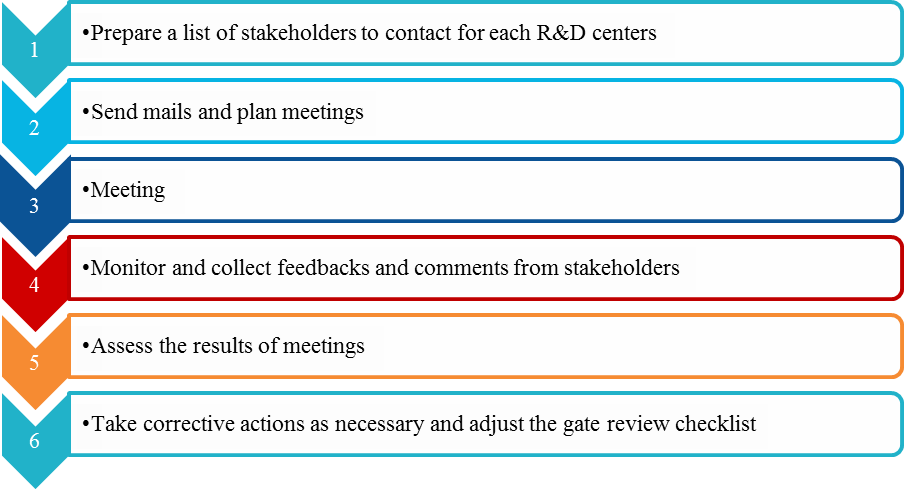 Figure
15
Figure
15 : How to bridge the communication
gap ? [8]
he stakeholders involved mainly project leaders
(experienced and new), Portfolio managers and
Quality manager
A checklist questionnaire for the meeting was
prepared in advance with open-ended questions as
follow:
1. First feedback
about the proposal of the gate checklist’s new
version (Format, sections …)?
2. Is there any
incomprehensible question?
3. Do you consider
this question mandatory or optional?
4. Is there any missed
question at this stage that is killer to the
project?
5. Do you suggest any
other areas of improvement?
Upon response to these questions, corrective actions
are undertaken to better fit the stakeholders’
needs.
The human factor played a crucial role to make a
better adapted Gate Checklists. Meetings were
undertaken in 3 different R&D centers: SGR, CRDC
and HRDC.
3.3.2.2
Project Audit
In order to support the feedbacks gathered from the
different interviews, a project audit was planned
and conducted on a pilot project in the Research
Center of Germany HRDC.
The evaluation of R&D projects within
Saint-Gobain is based on two criterias:
- Evaluation
of the steering committee
- Rating of the
project audit
The project audit was conducted by a qualified
auditor internal to the organization: the head of
quality management in the R&D center of Germany.
The audit is performed in 3 phases and usually
occurs after the stage 3 of the Stage Gate process:
Phase 1: Questionnaire development (Appendix
5)
This phase is focused on interviewing the
project leader to evaluate the performance of his
work and ensure that the major project keys points /
needs are met.
The audit checklist is sent to the project manager
and other stakeholders (audited entity) in advance
so they get informed about the questions.
The interview helps the auditor to get deeper
insights into the interviewee’s answers and
comments.
The checklist questionnaire reflects the project’s
successes, failures, challenges and missed
opportunities.
Phase 2: In-depth analysis
This phase is mainly based on assessing the issues
to get the root causes of the problem. Thus, the
auditor reviews all the deliverables/documentation
of the project according to the checklist
questionnaire.
Following this, the lessons learned and action plans
are identified in order to improve the performance
the project .
The improvement program is monitored by the audited
entity and must be completed within duration of 90
days. The auditor monitors the implementation.
Phase 3: Audit Report
This phase consists of collecting the information
and consolidating the documentation review.Then the
auditor creates and finalizes the audit report and
recommendations.
Another audit has to be planned to review the
corrective actions and action plans taken by the
project leaders and make sure that the deviations
have been corrected.
The main objective of a project audit is to identify
the action plans that can help improve the
performance and yield of a project as well as to
improve future projects. Therefore, project audit is
highly beneficial and recommended for every
organization.
The project audit helped to better assess the weak
points of the existing Stage Gate system.
On the basis of the communication with stakeholders
and project audit action plans have been taken. A
new gate review checklist have been implemented
which will be transferred in an ergonomic interface
(in progress). The planning of the review and
deployment phase is ongoing.
3.4
Results and perspectives
The main modification and improvement made are shown
in the following table:
Before |
After |
- 2
tools of gate review: Gate checklist
(excel sheets), Product Launcher
(intranet). |
- One common tool: Intranet for the
whole process from ideation to
Industrialization. |
- Heavy
tools, Many questions, redundant
questions, some poorly phrased
questions |
- Ergonomic facilitator tool
(Intranet) for the Stage-Gate process,
streamlined checklists, focused
questions and easy to understand.
- 4 sections:
R&D to be filled by the
R&D project leader.
MARKETING to be filled by the
Marketing responsible.
PRODUCTION to be filled by the
WCM responsible.
DECISION to be filled by the
Steering Committee. |
- Many
deliverables (too much paperwork) |
- Fewer deliverables (only the
project’s killers) |
- Problems
using the tool
- Project
leaders are left on their own and
gathering project data and managing
documents on their way. |
- Strengthened training of the project
leaders to the new tool. |
- Project
leaders not very involved and
motivated. |
- Raising awareness about the
importance of the new tool to better
manage projects and involvement of all
project leaders from the different
R&D centers.
- Informing and involving all project
leaders from the different centers. |
- Templates
for deliverables proper to HRDC and
CRDC
Templates do not exist
for other R&D centers |
- Common templates for deliverables to
be used by all the R&D centers
within SGG
(useful guide to help
structure the bare essential
information) |
- The
gate checklists are filled by the
Project leader |
- The new tool is filled by all
stakeholders |
Table
2: Comparison table before and after
optimization [8]
A sample of the new gate checklist is presented in
Appendix 4. The objective of this improvement is the
creation of a well-defined common process.
This new version of the checklist will be finalized
and validated during a meeting with a working group
composed of the quality managers of the different
R&D centers.
The action plans of this meeting:
• Discuss the new version of the
checklists
• Corrective actions
• Plan the release of the final
new version to the stakeholders
• Plan the training of
stakeholders
• Discuss the integration of the
WCM pillar in the Stage Gate Process
• Deployment on a project
• Transfer the checklists in an
ergonomic interface
At this point of the mission the two phases of the
SGRD were fulfilled successfully: SCREEN and GO.
The perspectives of this project are described in
Figure 16:
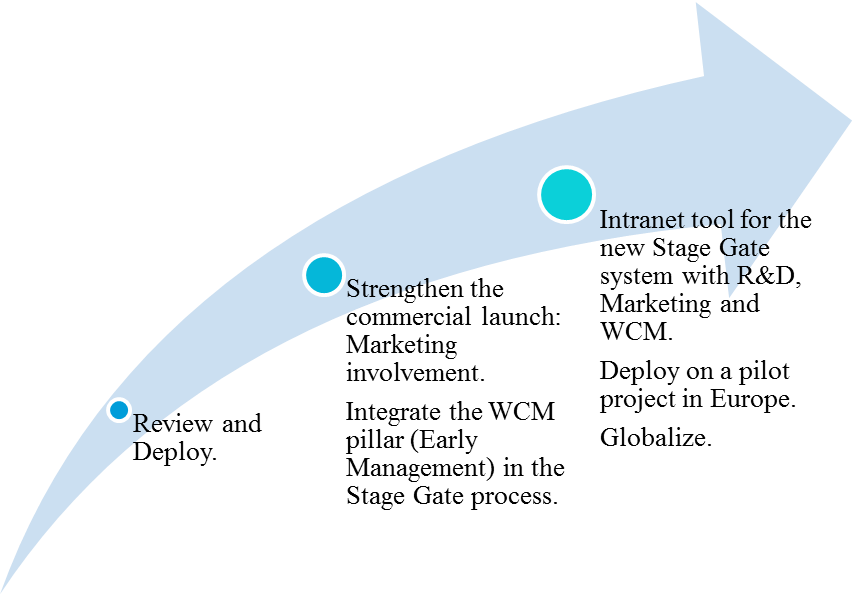
Figure
16: Perspectives of the project [8]
CONCLUSION
This thesis outlines the details
of the Stage Gate process for new product
development. It has tackled a challenge within
one of the most innovative companies, an
initiative to improve its existing system. A new
agile approach has therefore been built approach
to manage projects with all R&D centers of
Saint-Gobain Glass.
The method adopted was agile based mainly on
engaging the key stakeholders to solicit their
inputs and feedbacks for a better change
management.
As mid-term vision, Saint-Gobain Glass plan to
foster the marketing involvement in the Stage
Gate process and integrate the Lean
Manufacturing pillar :” Early Management”
at the end of this process.
As long term vision, Saint-Gobain Glass will
implement the tool for the new Stage Gate
process in an ergonomic intranet and deploy this
on a pilot project to finally achieve its
objective which is putting in place an
operational and common tool for all R&D
centers within Saint-Gobain Glass.
Upon completion of the internship I have
acquired skills at the interpersonal and
professional level (Appendix 2):
- Improvement of
communication skills (French and English
skills)
- Increase of autonomy
- Project management
- Autonomy
- Self-control capacity
- Confidence
- Put in practice the
Quality tools
- Keys points to manage
R&D projects (technical vocabulary …)
It was no doubt a valuable experience which
allowed me to discover new horizons. My previous
professional experiences were mainly focused in
laboratories and thanks to my internship within
Saint-Gobain I have learned what are beyond
laboratories and what is the purpose of Research
and Development and what comes next: A whole
step by step process. I therefore have learned
the methodology of conducting R&D projects
and their key elements.
The mission assigned was challenging. I had to
and implement a tool for 8 R&D centers of
Saint-Gobain Glass Industry. To fulfill this, I
had to coordinate with employees at every layer
mainly project leaders from different centers
and countries. I had to make sure that all
stakeholders are engaged and well informed about
the change.
Thanks to this, I have learned how to conduct a
good project management. Moreover, I
strengthened my leadership skills and
professional communication.
As a graduate in Industrial Chemistry with
double major in Quality Management, my interest
in working in innovative companies became
stronger. Developing my technical and management
skills for a better innovation is now at the
heart of my professional objectives.
BIBLIOGRAPHY
[1]
« Intranet Saint-Gobain-Innovative Materials
». [En ligne]. Disponible sur:
http://portal.saint-gobain.com/web/innovativematerials.
[Consulté le: 03-avr-2016].
[2] R. G. Cooper, S. J.
Edgett, et E. J. Kleinschmidt, « Optimizing
the stage-gate process: What best-practice
companies do-I - ProQuest ».
[3] « About Saint-Gobain
», Saint-Gobain. [En ligne]. Disponible sur:
https://www.saint-gobain.com/en/group/about-saint-gobain.
[Consulté le: 22-mars-2016].
[4] « Saint-Gobain
Presentation ». [En ligne]. Disponible sur:
http://portal.saint-gobain.com/web/communication/sgpresentation.
[Consulté le: 25-mars-2016].
[5] « Présentation Groupe
Saint-Gobain », Saint-Gobain. [En ligne].
Disponible sur:
https://www.saint-gobain.com/en/group.
[Consulté le: 24-mars-2016].
[6] « Portail Saint-Gobain
R&D ». [En ligne]. Disponible sur:
http://portal.saint-gobain.com/web/rd.
[Consulté le: 10-avr-2016].
[7] Compagnie de
Saint-Gobain, Innovator Handbook. 2009.
[8] E. Ben Jemia, «
Optimizing the R&D Stage Gate Process
for Saint-Gobain Glass », Université de
Technologie de Compiègne, Mémoire
d’Intelligence Méthodologique du projet
d’intégration,
https://www.utc.fr/master-qualite, puis «
Travaux » « Qualité-Management » réf n°344,
juin 2016.
[9] R. G. Cooper, S. J.
Edgett, et E. J. Kleinschmidt, « New product
Development Best Practices Study : What
distinguishes the TOP Performers », 2002b.
APPENDIX
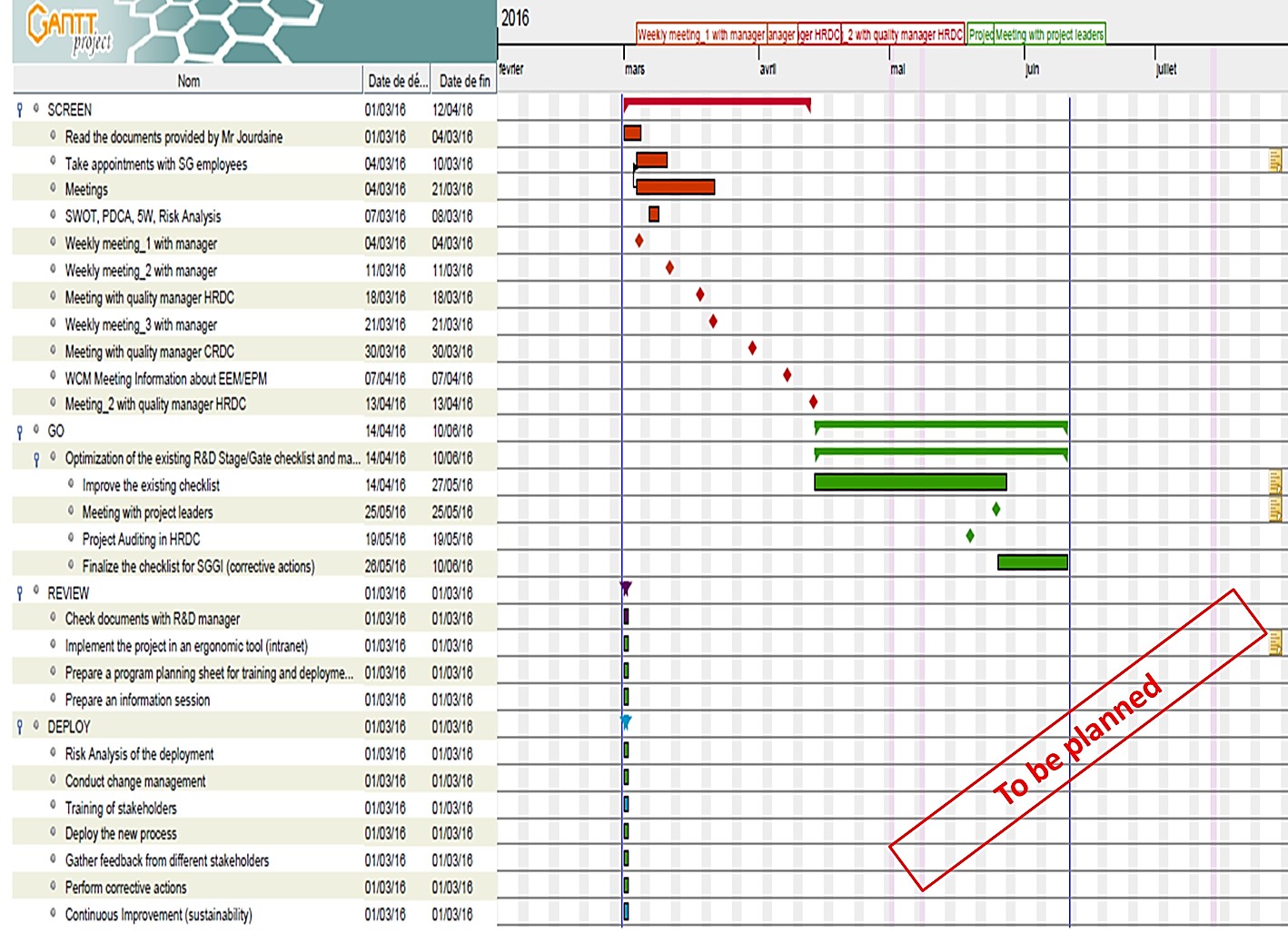
Appendix 1: Gantt Project
planning for the internship
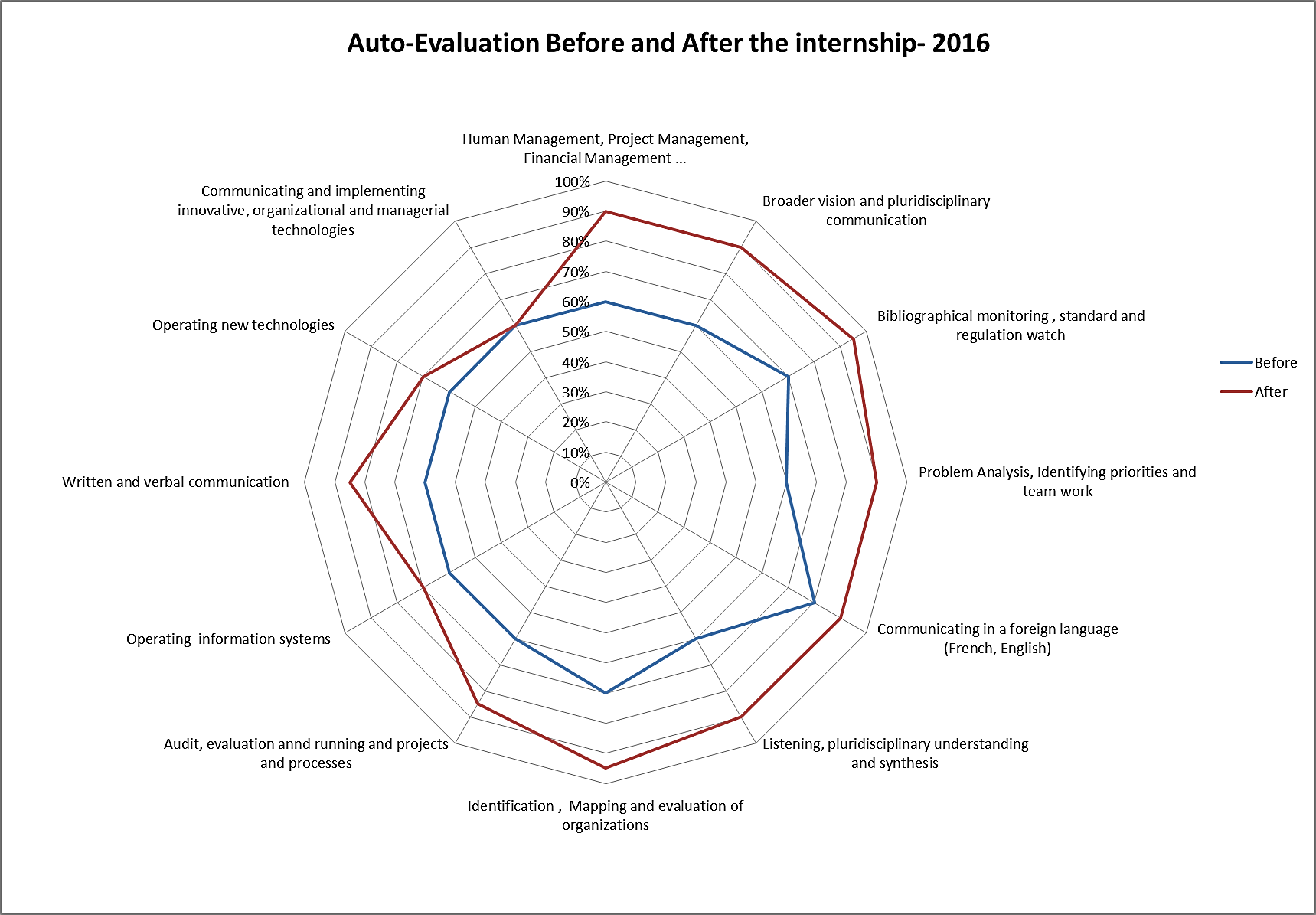
Appendix
2: Auto Evaluation before and after
the internship
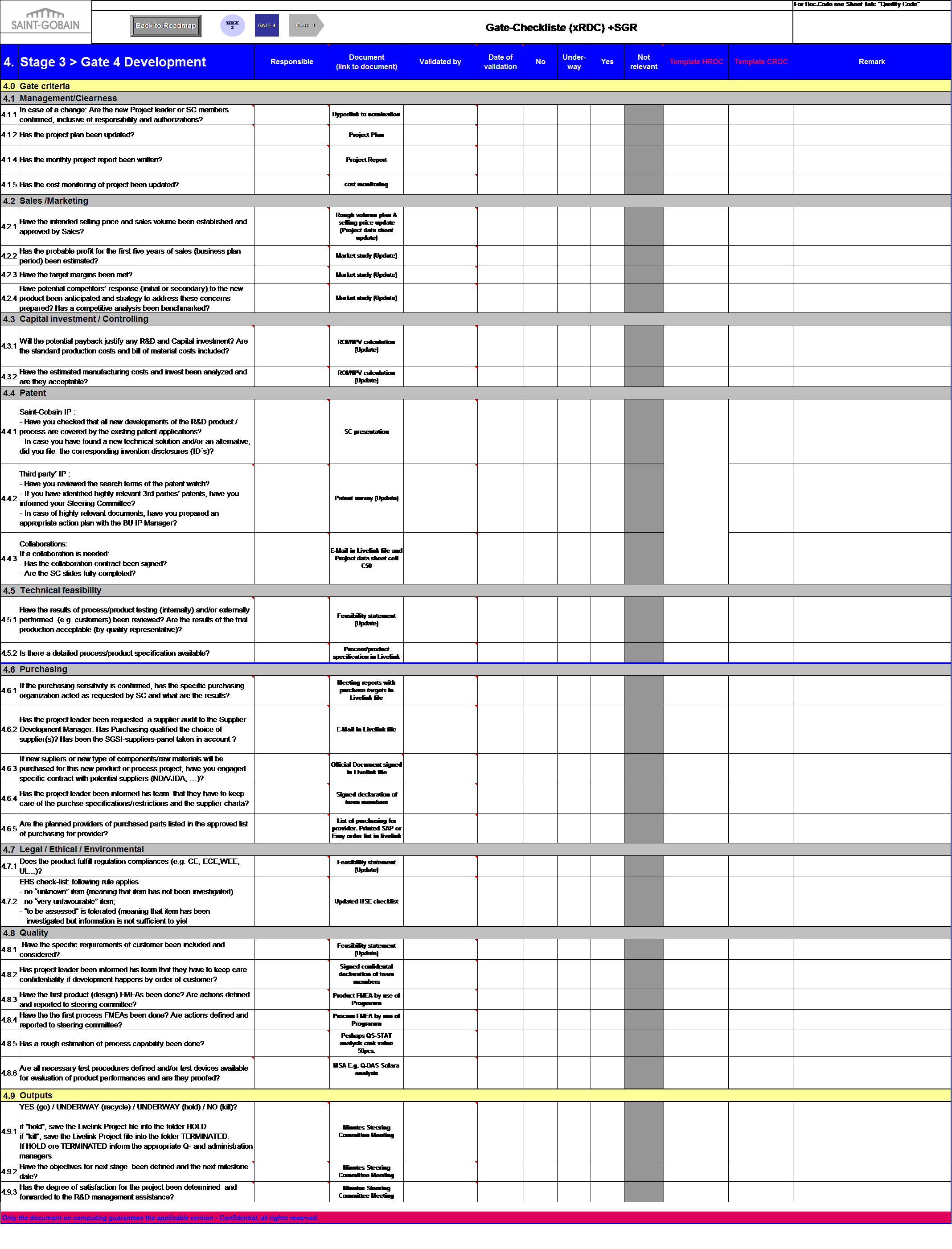
Appendix 3:
Sample of the existant gate checklist
(excel format)
Appendix 4:
Sample of the new gate checklist ( Gate 4)
(excel format)









